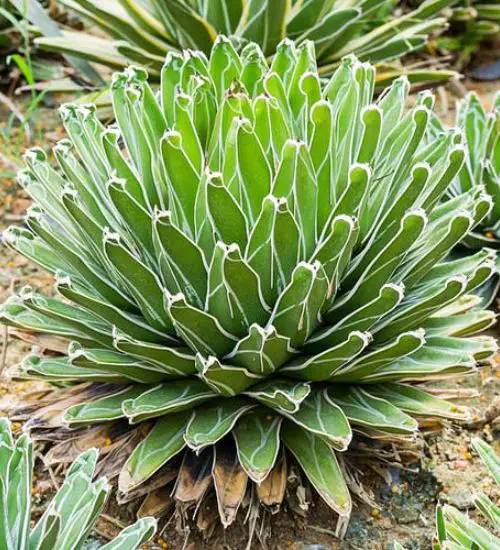Sun: full sun
Water: Typical water needs for a succulent
Temperature: Zone 9a from 20° F to 25° F (-6.7 ° C to -3.9° C)
Winter Survival: Not cold hardy
Propagation: offsets, seeds
Flower: rarely
Flower Type:
Toxic: Can be toxic to humans and animals
Dormant: winter
Space Requirement: Indoors & Outdoors
Common Problems: No major pests, Plants may rot if overwatered
Where to buy Agave victoriae-reginae?
Basc Care for Agave victoriae-reginae
Watering
You can water your succulent more than often in extreme conditions but make sure that the soil is completely dry before watering your succulent again.
Can you water your succulent more than what its need? The answer is yes and no. In extreme conditions, you can water your plants more often when you notice the soil is completely dry.
Fertilizing
Only feed this succulent during its active growing seasons which means spring and fall. Use the right fertilizer applied in the right amounts. Applying half-strength balanced fertilizer every month or so is recommended for optimal results.
Do not fertilize during winter as the plant is dormant.
Sun & Location Requirements for "Queen Victoria Agave, Royal Agave"
Agave victoriae-reginae requires full sun in order to thrive. When choosing a spot for your succulent, make sure it gets at least 6 hours of direct sunlight per day. If the leaves start to look pale or weak, this could be an indication that the succulent isn't getting enough light.
As per this succulent profile, it is only able to stay healthy when the environment temperature is above the range of zone 9a from 20° F to 25° F (-6.7 ° C to -3.9° C).
When temperatures drop below freezing, it is important to take precautions to protect Agave victoriae-reginae from the cold. Insulating and providing adequate drainage for the plant are key elements in helping it survive winter weather. Wind and sun exposure should also be minimized to prevent frost damage.
Agave victoriae-reginae also benefits from some indirect light throughout the day as well, so make sure you give it enough space to soak up light without becoming too exposed to heat.
Propagation
Succulents can be propagated easily by taking offsets from the mother plant and replanting them in fresh soil. The offset will eventually grow into a new succulent that is identical to its parent.
Propagating Agave victoriae-reginae from seeds is a great way to produce new plants without relying on cuttings or divisions. It's important to look for healthy, dark and plump seeds that are slightly sticky when touched. The soil should be pre-mixed with well-draining potting mix, before evenly sowing the seeds and pressing them into the surface. To ensure successful germination, gentle misting of the soil should be done and placed in indirect light.
Toxicity

The toxicity of Agave can vary depending on the individual species, but all species are potentially dangerous if ingested. Symptoms of poisoning may include vomiting, abdominal pain, diarrhea and dizziness. If you believe someone has ingested parts of Agave victoriae-reginae, seek medical help immediately.
Pests and Diseases
Agave victoriae-reginae is not affected too much by common pests and diseases like most of the other succulents.
It may get attacked by %pest_names%. To prevent this from happening, keep your succulent in a well-ventilated area and check it regularly for any signs of pests or health problems. If you do spot any, treat the plant using below methods.
%pest_treatment_methods%


